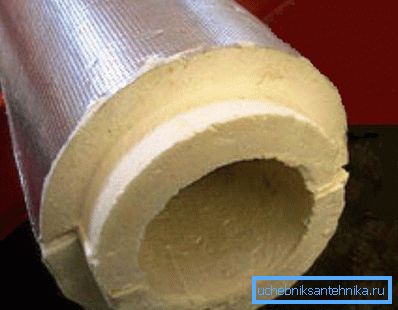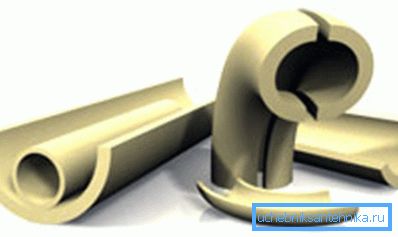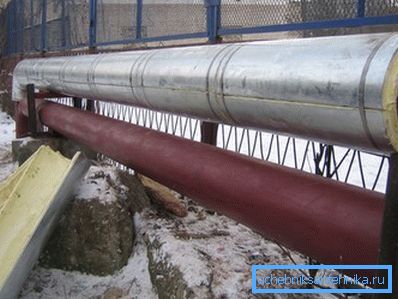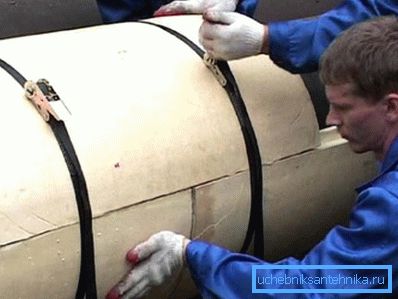Shell for pipes: studying the features and technology of
Pipelines for any purpose require compulsory warming, which allows to ensure the operation of highways in all weather conditions. The simplest way to protect the highway from the influence of adverse temperatures is a basalt shell for pipes, the main advantage of which is ease of installation.

What are the shell for pipes
The shell for pipe insulation allows you to significantly simplify the installation of insulation for communication lines. If you previously had to use rolled materials (glass wool or mineral wool) for thermal insulation, then you will be able to appreciate the advantages of the shell.
This product is available in two forms: as a hollow cylinder, or consists of two halves, which are joined to each other during installation. The edges of prefabricated elements can be both smooth and equipped with a groove-comb system, which significantly speeds up installation work and increases the level of thermal insulation efficiency.

Consider the example of the table features of various types of such insulation:
| Kinds | Specifications |
| Foamed polyethylene. Available in the form of a cylinder with a slot to facilitate installation. | Benefits:
Disadvantages:
|
| From expanded polystyrene. Hard in structure product, produced in the form of two halves, which can have either a lock or a lockless edge. | Benefits:
Disadvantages:
|
| Shell pp for pipes - is considered the most promising type of insulation. | Benefits:
|
Technical characteristics of PPU for the pipeline

Insulation of pipes with PPU shell today is the choice of both professionals and craftsmen (see also the article PPR pipe - features and applications).
This popularity is explained by the technical characteristics of PPU shell for pipes:
- Ease of work. Even a non-professional can install such insulation with their own hands, since it does not require any additional fasteners.
- Low weight, so that the total weight of the structure does not increase.
- The minimum coefficient of thermal conductivity.
- PPU shell for pipe insulation is not afraid of mold and fungi, and also has no interest for rodents.
- The service life of such insulation is about 50 years.
Note! After dismantling, the shell of the foam can be reused on other objects.
- Due to the minimum moisture absorption does not need to mount additional waterproofing.

Technology installation of thermal insulation
Thermal insulation for pipes shell PUF is not particularly complex.
The instruction assumes carrying out several stages:
- First of all, you should make sure that all elements of the pipeline are in integrity. In the event that you find a leak, it is necessary to carry out repair work in order to eliminate the causes of their occurrence.
Note! All insulation work should be carried out only in dry weather. Ensure that no condensation builds up on the insulated surface. Otherwise, the operational life of the pipeline will be significantly reduced.
- The surface of the pipeline must be treated with an anti-corrosion compound.. Primer paint can be used for this.
- Now you can proceed to the installation of insulation. Installation is carried out in such a way that there are no gaps between the elements of the insulation.
Note! For pipes of small diameter, a heater consisting of two halves should be used; in addition, it is advisable to install them in pursuit in order to ensure better fixation of the heat-insulating elements. For pipelines of large diameter, heat insulators consisting of several parts are more preferable.
- For greater efficiency of thermal insulation, experts recommend to glue the joints between the elements with foil tape.. It is sold in any construction store. If you do not have such scotch, you can get by with the usual one, but in this case the efficiency of work will slightly decrease.

- If the insulation for the shell pipes is mounted on pipes of large diameter, then its elements should be further strengthened, for which purpose use special clamps, knitting wire or steel tapes.
Conclusion
Today polypropylene insulation for pipes is the most popular. The high efficiency of PPU shells was tested by the operation of many communication lines with different uses. In addition to industrial use, such insulation for the pipeline is widely used in everyday life (see also the article Transparent pipe: materials and characteristics).
Therefore, if you want to significantly simplify the process of insulation, you should purchase this material. In addition, the laying of the pipeline with this type of insulation can be carried out directly into the ground.
The video in this article will provide more useful information on this topic.